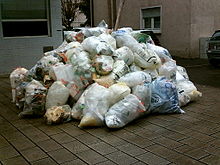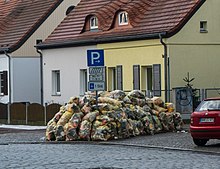Yellow bag
In Germany and Austria, a yellowish sack is a thin, yellowish, transparent plastic sack in which plastic, metal or composite material can be disposed of as part of local waste disposal . Depending on the coordination with the cities and municipalities, the use of a yellow bin may also be possible. Yellow sack and yellow bin are part of the dual system in German waste management.
Most of the waste collected in the yellow sack is sorted by machine in special sorting systems. In the first few years after the introduction of the yellow sack in 1991, a large part of the sorting still had to be carried out by hand, as the necessary techniques and machines were not available. The relevant technologies were developed in the 1990s and are now standard.
In some other European countries there are yellow garbage containers for the disposal of light packaging, whereby it is not necessary to pack the separated garbage in a special garbage bag before disposal. The dimensions of a (folded) yellow sack are 90 cm × 62 cm.
origin
Billions of sacks are manufactured “in the Far East ” and delivered to the municipalities by wholesalers and waste disposal companies, who in turn distribute them free of charge to households and also keep them ready to take away in town halls and recycling centers.
Collection and removal
The collection of the bags filled with rubbish is taken care of by companies commissioned by the dual system, either by garbage collectors or private disposal companies ; certain streets in a city are used on certain days of the week. When the collection takes place can usually be found out from the responsible city administration , if no waste information is available. In some counties (. Eg Pfaffenhofen district , district Ravensburg ), the yellow bags, however, must be transported by the citizens themselves at their own expense to central collection points that are open only on certain days; In 2014, a public survey took place in the Pfaffenhofen district. Via the disposal logistics , the yellow bags reach the garbage sorting facility , which does the sorting. The legal basis is provided by Section 6 of the Packaging Ordinance (VerpackV). The empty yellow sack is not recycled, but can be used as a substitute fuel e.g. B. be used in cement works. If it is too dirty, the remainder goes to the waste incineration plant .
content
The following rules must be observed regarding the content of the yellow sack or the yellow bin :
Only packaging items made of plastic, metal or composite materials belong in the yellow sack (or directly in the yellow bin) (examples):
- Plastic packaging
- Bubble wrap
- Aluminum cans and PET bottles that are deposit-free
- Washing-up liquid bottles, yoghurt cups, plastic tubes, toothpaste tubes, packaging for oral hygiene, hair and body care products
- Milk, water, juice and wine cartons (e.g. Tetra Pak ) - cartons made of composite materials (such as beverage cartons made of milk, juice or wine) belong in the yellow sack, as hygiene papers and handkerchiefs are made from the paper portion of this composite material can
- Plastic bags , ice packs
- Composite packaging
- Vacuum packaging for coffee, styrofoam packaging, etc.
- Packaging made of metal, aluminum foil, beverage and food cans, crown caps , metal closures, lids, blister packs for medicines, etc.
- heavy or hard objects such as B. Watering cans may only be disposed of in yellow bins
But to note:
- in Austria these metallic substances are collected separately in some municipalities
- In some municipalities in Bavaria , cans and other metal waste are still collected separately in depot containers
- certain items such as B. CDs, DVDs and batteries do not belong in the yellow bag, only empty plastic covers are allowed
- Glass belongs in the waste glass container - the separate waste glass collection existed before the introduction of the packaging ordinance
- Packaging made of cardboard , cardboard or paper is waste paper and should not be disposed of in the yellow sack.
Recycling rate
According to a response to a parliamentary question from the Bundestag member Bärbel Höhn , the recycling rates for tinplate in Germany in 2009 were 92 percent, aluminum 60 percent and plastics 43 percent. In 2012, according to the Society for Packaging Market Research (GVM), the material recycling rate was 93.1 percent for tinplate, 71 percent for beverage packaging and 48.2 percent for plastics. On behalf of the German Federal Environment Agency, GVM determined in a study published in 2015 that the amount of packaging waste in private households amounted to 8.06 million tons in 2013.
In Germany, less than half of the packaging from the yellow sack (and the yellow bin) is recycled. In 2014, however, 44.1 percent was disposed of in waste incineration plants. According to a calculation by the Öko-Institut , 51.1 percent was used as substitute fuel in cement works, 40 percent as input into material recycling, 6 percent as input into waste incineration plants and 2.8 percent as input into raw material recycling in blast furnaces.
future
The yellow sack could disappear in the long term, say scientists for waste management like Klaus Wiemer (Kassel) and Horst Fehrenbach at the Institute for Energy and Environmental Research (Heidelberg): As Germans are less willing to separate their garbage, expensive sorting machines could soon be useful. This is especially true if rising energy prices lead to competition for waste recycling. So far, however, new, complex sorting machines have not been economical.
In the Rhein-Sieg-Kreis 2011/12 Yellow recycling bin was introduced. In 2011, a pilot project for a recycling bin started in Herne. The Berlin recycling bin , which combines yellow sack and orange box, was launched in Berlin in 2013 . The Hamburg recycling bin was introduced in Hamburg in 2011 , and there has been a recycling bin in Cologne since 2014. In 2017, around 14 million German citizens had a recycling bin.
Web links
- Federal Association of the German Waste Management, Water and Raw Materials Management
- Altstoff Disposal Austria , organizes the collection in Austria
Individual evidence
- ↑ Sabine Ehrentreich: You pluck - it tears. In: Badische Zeitung , January 14, 2015.
- ↑ You searched for the series Waste separation abroad. Retrieved December 25, 2019 (German).
- ↑ Philipp Peters: In short supply yellow sack. In: Badische Zeitung , January 3, 2015.
- ↑ District Office Ravensburg - RaWEG-Sack. In: landkreis-ravensburg.de. Retrieved August 17, 2016 .
- ↑ Citizens' survey - waste management company in the district of Pfaffenhofen. In: awp-paf.de. Retrieved September 5, 2016 .
- ↑ Sorting information. Retrieved February 17, 2020 .
- ↑ https://www.nabu.de/umwelt-und-ressourcen/abfall-und-recycling/recycling/21113.html
- ↑ Hans von der Hagen: The yellow sack: Twelve mistakes about the yellow sack. Retrieved February 28, 2020 .
- ↑ Ecological effectiveness and economic efficiency of the dual systems in German waste management. German Bundestag , April 4, 2013 (PDF; 169.47 kB).
- ↑ Higher recycling rate for 2012. In: 320 ° , February 20, 2014.
- ↑ www.umweltbundesamt.de (PDF; 4.57 MB).
- ↑ DPA: incinerated instead of recycled. In: Zeit Online , October 18, 2016.
- ↑ Öko-Institut: Environmental potentials of the separate collection and recycling of valuable materials in the dual system , 2016, p. 19 (PDF).
- ↑ GA BONN: Rhein-Sieg-Kreis: Recyclables bin has established itself. Retrieved December 25, 2019 .
- ↑ Disposal Herne will set up the first recycling bins on Monday. In: radioherne.de .
- ↑ Berlin recycling bin. Retrieved December 25, 2019 .
- ↑ Recycling bin of the city of Cologne .
- ^ Federal Ministry for the Environment on the recycling bin ( memento from October 20, 2017 in the Internet Archive ).




